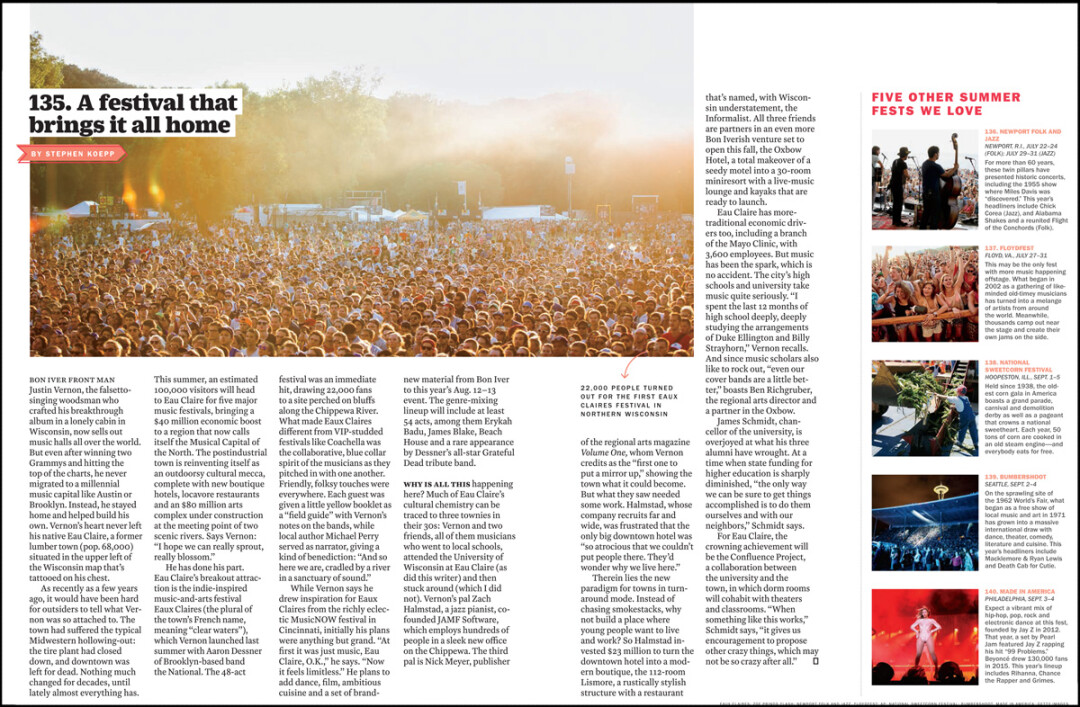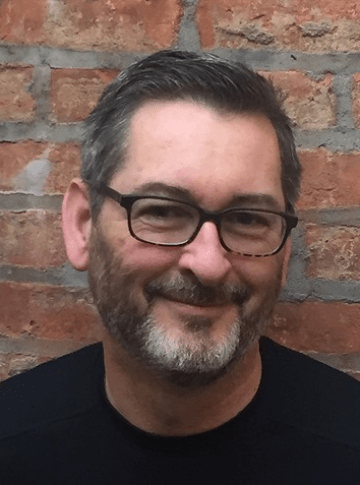Time Magazine Features Eau Claire

In this week’s issue of Time Magazine – hitting newsstands soon but online now (for a $3 fee) – you’ll find a robust story on ... Eau Claire. Yep, the iconic magazine is featuring our little chunk of Wisconsin, covering the city’s recent economic and cultural developments.
The story, part of a series called “Reasons to Celebrate America,” credits music as a major starting point in Eau Claire’s recent evolutions. It highlights the region’s lineup of summer music festivals (focusing on Eaux Claires), Justin Vernon’s decision to stay based in the area, Zach Halmstad and JAMF Software, and Volume One’s own editor/publisher Nick Meyer. In describing the city’s recent Lismore and Oxbow hotel developments, the article states, “Therein lies the new paradigm for towns in turnaround mode. Instead of chasing smokestacks, why not build a place where young people want to live and work?”
"I think [Time] readers will see how it’s not just bigger places like Portland and Denver and Brooklyn that can revitalize themselves for a post-industrial world, but smaller towns like Eau Claire, too. For Eau Claire, it was a matter of understanding its own strengths and then making some bold investments." – Steve Koepp, former deputy managing editor of Time Magazine
The piece was written by Steve Koepp, who spent 35 years at Time Inc. – much of it as the deputy managing editor for Time Magazine. He was also the executive editor of Fortune for five years (he’s currently a freelance journalist). And as it so happens, Koepp is a native of Pewaukee, Wis., and he attended UW-Eau Claire from 1974–78. While at Time, Koepp kept contact with the university, sponsoring a journalism fellowship which brings students to New York to spent a few weeks at the magazine.
On a trip to Eau Claire in May to award a fellowship, Koepp was impressed by what he saw – this is not the Eau Claire the remembers. The experience inspired him to produce the piece for Time. As a little behind-the-scenes extra to the article, we interviewed Koepp on how the piece came about.

What did you see in the area that made it so compelling?
I hadn’t been to Eau Claire in about a decade, but I’ve maintained contact with UWEC. I met with UWEC chancellor Jim Schmidt in NYC and the Eau Claire that he described, with great enthusiasm, was not the Eau Claire that I remembered. The Jazz Fest, the Confluence Project, JAMF Software, boutique hotels, and loft apartments. My curiosity was kindled. When I visited campus in May to award a fellowship, I had a chance to witness it all firsthand. I stayed at the Lismore Hotel during its first few days of operation, visited Phoenix Park (where a wedding was taking place), checked out the site of the Confluence Project.
It was still a little chilly, but I imagined what it would be like with concerts along the river and tubers floating along. These were the sights and sounds of a place coming alive. Another thing that struck me, in conversations with folks in Eau Claire, was the mixture of enthusiasm and a sense that they couldn’t quite believe that these things were happening after many decades of Eau Claire being in the doldrums.

What about Eau Claire do you feel is important for "outsiders" to understand?
That the beautiful scenery and the cultural vitality flow together, kind of like the rivers and maybe even because of them. And that alongside the natural beauty is a sophistication that’s deeply rooted, notably in the tradition of music education that extends from the high schools through the university. What’s noteworthy now is that these attributes are coming together in experiences that outsiders can appreciate. The rivers that were once dirty, industrial infrastructure are now supplying inspiration and recreation.
How do you hope Time readers will react to the piece?
I hope some readers, especially those from outside the region, will be inspired to visit, have a wonderful experience, and help continue its growth and development. Clearly, there is still work to be done.
On a broader scale, I think readers will see how it’s not just bigger places like Portland and Denver and Brooklyn that can revitalize themselves for a post-industrial world, but smaller towns like Eau Claire, too. For Eau Claire, it was a matter of understanding its own strengths and then making some bold investments.


















